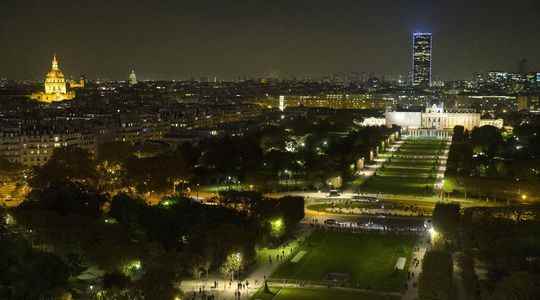At night, all cats are gray, as the saying goes. But once the streetlights are turned on, the animals do not change color, rather their behavior. Insects are attracted to these light sources and become exhausted circling around them. Bats, on the contrary, flee them. Some deer no longer dare to cross an illuminated road and migratory birds, usually guided by the stars, can get lost when approaching cities whose light blurs their bearings. Far from being exhaustive, the list illustrates the impact of artificial light on nocturnal biodiversity and the importance of this subject in scientific research. “It is gaining momentum at all levels”, confirms Jennifer Amsallem, ecologist by training, study engineer at the National Research Institute for Agriculture, Food and the Environment (Inrae). Because the disturbance does not only concern a handful of species: around 30% of vertebrates and 65% of invertebrates – among them many pollinating insects – are nocturnal, according to a study from 2010.
The Biodiversity Conference (COP 15), which opens on December 7 in Canada, should validate the next global framework supposed to put biodiversity on the path to regeneration by 2030. It is unlikely that the case of light pollution. Nor its consequences: the disruption of the life cycles of fauna and flora, of hunting territories, the fragmentation of natural habitats… However, initiatives are developing with a little more force each year, and in particular experiments black screen, a concept in which France is a pioneer.
Movements of species and luminous obstacles
This concept is in line with that of green and blue frame (TVB) aimed at maintaining an ecological network, made up of reservoirs and corridors where animal species can circulate and ensure their life cycle. The dark frame, where light pollution is reduced to a minimum and darkness protected or restored, thus forms an additional layer of protection for nocturnal biodiversity. “The concept has long remained fairly confidential. Mapping a dark frame means having data to identify the challenges of biodiversity and the movement of species, analyze light obstacles and recommend the sectors on which to act as a priority”, continues Jennifer Amsallem . However, collecting detailed data – orientation, power, color of lighting – is not always easy with local authorities. And even less private actors.
Despite these obstacles, the initiatives are progressing. The French Office for Biodiversity (OFB) identifies around twenty territories which have begun to identify their dark frame. And requests are pouring in from design offices or specialists, notes the Inrae engineer, who is working on the dark fabric of the Montpellier agglomeration. Abroad, the concept has not yet been echoed, “outside the canton of Geneva (Switzerland)”, notes Romain Sordello, ecological engineer at the PatriNat mixed service unit, a center of expertise and data on natural heritage under triple supervision (OFB, National Museum of Natural History, CNRS). But a collective of French and international researchers of which he is a member called, last March, for its development on a larger scale..
“Do we know how to plan a dark screen? No”
Problem: the use and current conception of the concept are debated among French experts on the subject. “The black frame is inoperative today in its practical dimension. It is due to an excessive superposition, affirms Samuel Challéat, geographer and researcher at the CNRS. There are as many reactions to artificial light as there are species, as many scales than species. How to choose which one to protect first? If he used the term black screen for a long time, he now favors that of dark ecological network. Because according to him, the doctrine developed in recent years by the OFB on this point is “a technostructure of the living. Do we know how to plan a black frame? No. Finally, yes, for three species of bats smile. That’s all”.
The geographer defends another approach. “If we start from the principle that light is always a disturbance for biodiversity, which is the case, it is better to speak of illuminated frames, with the idea of restoring permeability, that is to say darkness, on these”, explains Samuel Challéat. Another way of thinking about land use planning, which may be delimited by a national guide but must take into account local specificities. “Without necessarily the need for heavy artillery in terms of planning,” he adds.
“It is a type of reversible pollution”
All agree, however, that the subject of light pollution, which stargazers were the first to seize, has been “in vogue for several years, even before benefiting from the effects of Covid-19 and the energy crisis, notes Jennifer Amsallem .Maybe because it is a type of reversible pollution, where you just have to press a button”. And communities, while their electricity bills are exploding, are getting into it with more enthusiasm – “hoping it’s not just temporary”, points out Romain Sordello. Some switch off the lighting for a period of time at night, others change the color temperature or the intensity of the luminaires, or even their orientation. “We can always do more, agrees the engineer at PatriNat. For example in spring or autumn, even in the event of extinction in the middle of the night, we lose ‘night time’ at dawn or dusk. , where many species are already active.”
When defining extinction thresholds, the notion of public acceptability remains essential. 1 hour? 11 p.m.? Earlier still? “There are still a lot of a priori, especially on issues of road safety or property,” reports Romain Sordello. “Lighting must be thought out according to the real needs for man, which has not necessarily been the case in the past”, adds Jennifer Amsallem, who insists on the need for consultation. Samuel Challéat hopes that this awareness of light pollution will trigger a deeper reflection “on our light needs: are they all vital? Where do we place the cursor?” For nocturnal species that cannot be seen, it is a matter of survival.
